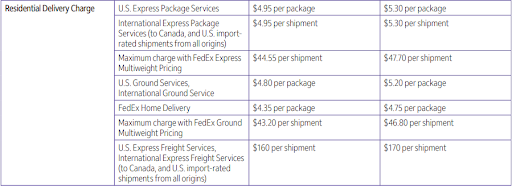Shipping is shipping, right? The items are wrapped up and a shipping label is prepared. The package goes from the shipper to the carrier to the recipient. So why does it cost different amounts, and why do carriers want to know if you are sending the parcel business vs residential shipping? As an ecommerce business or a retail store selling to both businesses and individuals, this difference adds complexity to the decision process of which carrier to use and how to better plan for shipping costs in the pricing, especially if free shipping is an option. Residential vs commercial shipping: it makes a difference which you use!
What does residential shipping mean?
In its most basic sense, residential shipping means the shipper is sending items to a home or private residence, aka a home delivery. But that is a simplistic way of looking at it because some businesses are based in homes. And that business might be receiving large quantities of boxes and supplies. A business can also be based in a residential area, and may be identified by shippers as a residential address, even if it’s a freestanding building only housing that business.
It doesn’t matter if the residential delivery is parcel shipping, LTL freight shipping, or specialty services like White Glove delivery, a type of LTL shipping. If it’s a residential address, it will often cost you more. In residential vs commercial shipping, it matters if the business is based in a residential area because those surcharges add up, increasing the cost of doing business.
What does business shipping mean?
Business, or commercial shipping, means the order goes to a business address. “Business” is a broad term, which can be a store, or it can be a manufacturing plant, a healthcare system, a house of worship, or a farm. Commercial shipments tend to be larger quantities of packages than residential addresses. They can also be LTL freight or FTL freight shipments.
While some businesses are classified as residential deliveries because they are in residential areas, the reverse can be true as well. Some residences are in commercial locations. Or you can get a situation where a large apartment complex, especially one with mixed–use, is deemed commercial by the carrier. The shipping company can classify the location based on its own rules. The carrier might also rely on the government’s zone designation as business vs residential for shipping.
Is business shipping cheaper than residential?
Usually, business shipping is cheaper than residential shipping. Residential shipping tends to be delivered to a lower-density area. That means delivery drivers make more stops on average, and the locations are farther apart. The residential streets can also be more difficult to navigate if they are narrower with cars crowding the curbs. That makes it hard to maneuver. They may need to send smaller trucks without tailgates. Additionally, these smaller trucks can carry and deliver fewer packages simultaneously compared to a larger 18-wheeler that is delivering multiple pallets or a larger volume of parcels to one location. Residential roads may have town restrictions on weight, and drivers may need to watch for heavier pedestrian traffic and kids en route to or from school. These are some of the reasons that residential deliveries can be more expensive.
Conversely, commercial addresses tend to be on more accessible streets, clustered closer together. That means one truck can deliver more packages — faster and with fewer resources. And this matters, since a big portion of the shipping cost is in the last mile portion.
Shipping zones
Note that it does not have to be more expensive to deliver to residential addresses. Carriers can decide which areas are designated for business vs residential shipping and when to add accessorial fees. Perhaps a residential address uses a dock and has a high volume of packages. Or they are on a wider street that can accommodate bigger trucks. The carrier may not put that address in the residential zone, thus lowering the cost of shipping. On the other hand, a commercial address may also fall near or in a residential area and may be charged residential rates.
The carriers will often follow the city’s zoning designations, so if an address is in the residential area, it charges extra for that, versus those in the commercial area. That said, there still could be higher expenses if the delivery truck is too large to safely deliver to the address, resulting in additional costs like a redelivery fee or failed delivery attempt.
Minimizing the costs for residential vs commercial shipping
With costs typically higher for residential vs commercial shipping, there are some ways to mitigate those costs. Knowledge is power!
Inflation has hit shipping costs like it hit so many other sectors. FedEx raised its rates for residential delivery charges for various services between 2021 and 2022.

*Image source: Fedex
UPS also charges a residential accessorial charge for businesses operating out of homes.

To lower the cost of business vs residential shipping, there are a few options. The first is to find carriers that identify the areas of most importance to that shipper as a commercial delivery area. There could be multiple reasons they would do that, as mentioned earlier. You could use multiple carriers for your delivery needs, or move your business over to that carrier, if it makes the most sense holistically. Finding a shipping service that best suits your needs and address can be a great yet simple way to lower your shipping rate.
Understanding shipping costs
It’s helpful to understand all the pricing options that impact your shipping needs, and this can be done on a case-by-case basis if you have relationships with multiple carriers. Shipping software is a great way to do this. The shipping software may present you with the option to make decisions per package. Or you can enter the parameters for choosing one carrier over another, whether it’s cost, delivery timing, or any special circumstances. The software can then manually generate the most appropriate shipping label or kick the package over to someone to make a decision if there’s an exception to the parameters.
Ecommerce companies can make shipping costs transparent and charge customers for the shipping cost. This can be difficult if competitors offer free shipping, but if it means a company can stay in business, then it’s something to consider. Offering customers the choice of ground shipping versus a faster form of shipping can also lower costs, sometimes including a lower residential delivery fee.
Lastly, send packages through the United States Postal Service. USPS is mandated to deliver to all homes in the country, and they do not charge extra for home delivery. It’s what they do. To get the best commercial rates with the USPS, consider its cubic shipping option, which lowers the price considerably. You may have to choose different packaging materials to get the best size and price.
Negotiating surcharge fee
It’s possible to negotiate the residential surcharge fee with carriers. It’s best not to do this as a one-off, but rather as part of an overall negotiating strategy. Small shippers with lower volume may not have as much leverage as larger shippers, but it’s still worth trying. Some smaller shippers get the same discounts using shipping software as they may get on their own.
Shippers that have their own carrier contracts, though, should optimize the contracts by understanding the spending and sending patterns, and then using that data to negotiate discounts. Parsing the shipping patterns can be done by someone internally at your company. But, unless the person has a vast background in shipping, specifically on the carrier side, you would probably get more from the effort by using a specialist. Shipware’s experts come from the carrier side. They can dig through the shipping data to understand where a company spends the bulk of its money, where it is likely to get the most savings from negotiations, and how to use that data — including proprietary benchmark data — to gain those savings from the negotiations. Shipware then walks you through the strategy side, to help you realize the most savings for the areas most pertinent to your shipping needs. Contract optimization can save you up to 30% of your shipping costs.
Shipware can help control residential vs commercial shipping costs
Understanding how a shipping service works can be a big indicator of how much your shipping rate may be. Erroneous residential delivery surcharges can be caught through an invoice audit recovery program. This automated software program Shipware offers can analyze countless invoices to spot errors that a human would not be able to find. By flagging incorrect residential surcharges, and other mistakes a carrier makes, the program can help a shipper recover credit that would otherwise be lost. Shipware customers save up to 9% of their shipping costs with no cash outlay by using this software. There is no upfront cost to use the program, and all fees are covered by savings. The carrier applies credits directly to your account, making the process transparent and easy.
There is a higher cost to shipping to residential addresses, but it does not have to be a budget-killer. Understanding how the accessorial charges work and ways to avoid some of them can play a big role in lowering shipping costs. To learn how to make some other simple changes to lower your shipping rates, please contact us.
